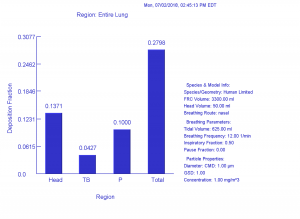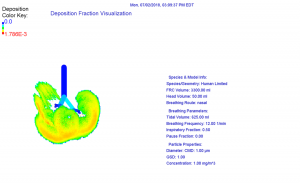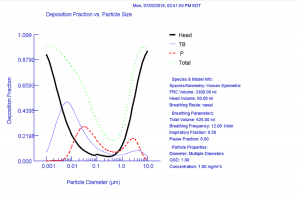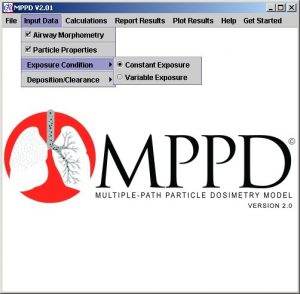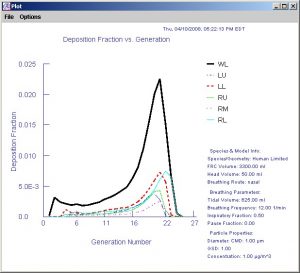MPPD: Multiple-Path Particle Dosimetry Model

The MPPD model is a computational model that can be used for estimating human and laboratory animal inhalation particle dosimetry. The model is applicable to risk assessment, research, and education.
- MPPD v 3.04
- MPPD v 2.11
Multiple-Path Particle Dosimetry Model (MPPD v 3.04)
The MPPD model calculates the deposition and clearance of monodisperse and polydisperse aerosols in the respiratory tracts of laboratory animals and human adults and children (deposition only) for particles ranging in size from ultrafine (1 nm) to coarse (100 µm). Respiratory tract dosimetry models have been developed for several laboratory animal species including rat, mouse, rhesus monkey, pig, and rabbit. The models are based on single-path and multiple-path methods for tracking air flow and calculating aerosol deposition in the lung. The single-path method calculates deposition in a typical path per airway generation, while the multiple-path method calculates particle deposition in all airways of the lung and provides lobar-specific and airway-specific information. Within each airway, deposition is calculated using theoretically-derived efficiencies for deposition by diffusion, sedimentation, and impaction within the airway or airway bifurcation. Filtration of aerosols by the nose and mouth is determined using empirically-derived efficiency equations. The MPPD model includes calculations of particle clearance in the lung following deposition for humans, rats, and mice.
Eight tutorials are provided so that the user can learn to interact with the software.
If you have any questions, please contact MPPD support.
References
Anjilvel, S. and Asgharian, B. (1995). A multiple-path model of particle deposition in the rat lung. Fundam. Appl. Toxicol. 28, 41-50.
National Institute for Public Health and the Environment (RIVM) (2002). Multiple Path Particle Dosimetry Model (MPPD v 1.0): A Model for Human and Rat Airway Particle Dosimetry. Bilthoven, The Netherlands. RIVA Report 650010030.
Miller, F.J., Asgharian, B., Schroeter, J.D., Price, O.T. (2016). Improvements and additions to the Multiple Path Particle Dosimetry model. J. Aerosol Sci. 99, 14-26.
Features
- Human (single-path symmetric, 5-lobe symmetric, asymmetric stochastic, original Weibel symmetric, and PNNL-provided models from CT scans), rat (symmetric and asymmetric for Long-Evans and Sprague-Dawley strains), mouse (BALB/c and B6C3F1 strains), rhesus, pig, and rabbit lung geometries included
- Human adult and children lung geometries representing 10 distinct ages from 3 months old to 21 years old
- Models upper respiratory tract deposition (nasal, oral, oronasal, or endotracheal breathing)
- Models lobar, tracheobronchial, and alveolar lung airway deposition and clearance
- Models particles ranging in diameter from 0.001 to 100 µm
- Models monodisperse and polydisperse particles as well as multimodal particle size distributions
- Accounts for individual breathing parameters such as breath frequency, tidal volume, inspiratory and expiratory fractions, functional residual capacity, and upper respiratory tract volume
- Models variable exposure scenarios and activity patterns over a length of time
- Models lung clearance during and after a long-term exposure with default or user-determined clearance parameters
- Detailed output reports with complete deposition and dosimetry information available by individual, by lobe, by respiratory region, by airway generation, or by individual airway
- User-friendly and customizable plotting of output data
- Extensive help documentation, references, tutorials, and a quick start guide
buy now
Select product tab for purchase options
- MPPD v 3.04
Multiple-Path Particle Dosimetry Model (MPPD v 3.04)
Free Download
You are now entering ARA's Secure Online Store
Multiple-Path Particle Dosimetry Model (MPPD v 2.11)
The MPPD model is a computational model that can be used for estimating human and rat airway particle dosimetry. The model is applicable to risk assessment, research, and education.
The MPPD model calculates the deposition and clearance of monodisperse and polydisperse aerosols in the respiratory tracts of rats and human adults and children (deposition only) for particles ranging in size from ultrafine (0.01 µm) to coarse (20 µm). The models are based on single-path and multiple-path methods for tracking air flow and calculating aerosol deposition in the lung. The single-path method calculates deposition in a typical path per airway generation, while the multiple-path method calculates particle deposition in all airways of the lung and provides lobar-specific and airway-specific information. Within each airway, deposition is calculated using theoretically derived efficiencies for deposition by diffusion, sedimentation, and impaction within the airway or airway bifurcation. Filtration of aerosols by the nose and mouth is determined using empirical efficiency functions. The MPPD model includes calculations of particle clearance in the lung following deposition.
Eight tutorials are provided so that the user can learn to interact with the software.
If you have any questions, please contact MPPD support.
References
Anjilvel, S. and Asgharian, B. (1995). A multiple-path model of particle deposition in the rat lung. Fundam. Appl. Toxicol. 28, 41-50.
National Institute for Public Health and the Environment (RIVM) (2002). Multiple Path Particle Dosimetry Model (MPPD v 1.0): A Model for Human and Rat Airway Particle Dosimetry. Bilthoven, The Netherlands. RIVA Report 650010030.
Features
- Human (single-path symmetric, 5-lobe symmetric, and asymmetric stochastic) and rat (asymmetric) lung geometries included
- Human adult and children lung geometries representing 10 distinct ages from 3 months old to 21 years old
- Models upper respiratory tract deposition (nasal, oral, oronasal, or endotracheal breathing)
- Models lobar, tracheobronchial, and alveolar lung airway deposition and clearance
- Models particles ranging in diameter from 0.01 to 20 µm
- Models monodisperse and polydisperse particles
- Accounts for individual breathing parameters such as breath frequency, tidal volume, inspiratory and expiratory fractions, functional residual capacity, and upper respiratory tract volume
- Models variable exposure scenarios and activity patterns over a length of time
- Detailed output reports with complete deposition and dosimetry information available by individual, by lobe, by respiratory region, by airway generation, or by individual airway
- User-friendly and customizable plotting of output data
- Extensive help documentation, references, tutorials, and a quick start guide
buy now
Select product tab for purchase options
- MPPD v 2.11
